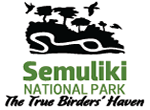Semuliki harbours a biological richness unmatched by any other lowland tropical forest ecosystem in Uganda.
Its location at the intersection of the Central African and East African ecological zones has produced a complex mosaic of life, in which West African forest species coexist with Albertine Rift endemics in a relatively compact area.
The result is an extraordinary level of biodiversity, both in vegetation and wildlife forms, shaped by centuries of evolutionary and climatic continuity.
Plant communities in Semuliki exhibit a dense stratification, from towering canopy trees to shaded understory thickets.
This intricate vegetative structure supports equally specialised fauna, some of which occur nowhere else in the country.
The diversity is not just extensive in numbers but distinctive in ecological behaviour and adaptation.
Unlike other national parks dominated by savannah systems or montane forests, Semuliki’s lowland rainforest hosts species more typical of the Congo Basin than of East Africa.
Understanding the flora and fauna of Semuliki is critical not only to appreciating its ecological uniqueness but also to grasping the delicate balance that sustains its intricate life systems.
Ecological Zones in Semuliki National Park
Semuliki’s ecological structure is shaped by its position on the floor of the Albertine Rift, adjacent to the Congo Basin.
The park lies at an altitude of 670-760 metres above sea level, which explains its affinity with lowland rainforest systems.
Despite its compact size of 220 square kilometres, it supports a diverse range of environments. The following zones provide the physical foundation for the area’s biological complexity.
1. Lowland Tropical Rainforest
This is the dominant ecological zone, covering over 85 percent of the park’s area. It forms part of the easternmost extension of the Ituri Forest system. The canopy rises to 45 metres in some sections, often composed of ironwood (Cynometra alexandri), fig trees, and Albizia species. Below this, a continuous understory layer supports ferns, shrubs, lianas, and epiphytes.
The rainforest’s high humidity, low light penetration, and consistent rainfall (averaging 1,250 millimetres annually) create conditions for evergreen growth and niche-specific fauna. Most of Semuliki’s mammal, bird, and amphibian diversity is concentrated in this zone. Species here depend heavily on vertical stratification for feeding, nesting, and predator evasion.
2. Swamp and Riverine Systems
The meandering Semuliki River and associated floodplain form these wetlands. The river originates from the Rwenzori Mountains and eventually drains into Lake Albert. Its banks are fringed with raffia palms, swamp grasses, and patches of papyrus, particularly in low-lying depressions.
This zone provides year-round feeding and breeding grounds for aquatic and semi-aquatic species, including Nile monitor lizards, red-legged frogs, and marsh birds such as the African jacana. Faunal mobility is seasonal, particularly after river swelling events in April and November.
3. Hot Springs and Geothermal Microhabitats
The Sempaya hot springs represent a localised but ecologically distinct zone. Though small in area, the geothermal influence alters the chemistry of surrounding plants and soil pH, supporting thermally adapted microorganisms and changing species composition in nearby thickets.
Insects, lizards, and small mammals frequent these heated clearings, drawn by mineral deposits and warmth. Bird species are known to hover near these spots for foraging, especially during early hours.
4. Woodland-Edge and Grass Transition Zones
Along the northeastern boundary and near park entrances, semi-deciduous woodland and short grass patches emerge. These transition areas experience more direct sunlight and are less humid than the rainforest core. Acacia and combretum trees appear occasionally, though their spread is limited.
Species in this zone show higher mobility. Baboons, bushbuck, and forest buffalo often forage here before retreating into denser cover—insect and bird activity spikes during dry spells, when resources become concentrated along edges.
5. Anthropogenic Buffer and Cultivated Fringes (Outside Core Area)
While technically outside the protected park boundary, neighbouring farmlands and Bamba-Batwa settlements influence ecological continuity. These buffers experience human-modified microclimates due to cultivation, firewood extraction, and grazing.
Edge-tolerant species such as rodents, mongooses, and particular birds frequent these strips. Occasional crop raids by forest elephants and chimpanzees further highlight the ecological permeability of these fringes.
